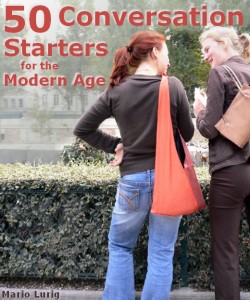
Whether your intentions are good and your talents exceptional, if your motivations for writing are strictly financial, your book sales will suffer. Period.
It’s humbling, and it is hard, but it’s a lesson to be learned by established authors and new authors alike. A few months ago, I noticed that there was a price gap in the listed e-books for conversation starters or ‘book of questions’ style books. There were no books under $9.99, and thus nothing at the impulse $2.99 price point. So, since most who know me would agree that this was an area I was talented, I decided to design the type of book that would fit at that price point, write it, test the quality of the conversation starters using Amazon’s Mechanical Turk and a SurveyGizmo survey, and publish it across Amazon, Barnes & Noble, and the Apple bookstores.
Simple right?
- Find price point
- Write content
- Publish
- …
- Profit!
The problem was my motivation for writing the book. Let’s be clear, I’m not giving up on it just yet (I have some great business cards that advertise the book in a unique way that I can leave around at social events), but the sales have been less than stellar. My goal was 200 sales per month, based upon some competition research and the price point. However, the best sales were the first few months, before 2 not-so-good reviews, and still sales were only at 30 copies per month. At that price point, I was still making more money and feeling better about each sale from my first book. Now, it’s not a direct comparison, because the books are not even in the same market or audience, but that’s not the point of the story.
Be careful of your motivations. Great books, regardless of audience; opportunity; or author, are written because they meet a need and were filled with the passion of the author. Sure, passion doesn’t sell books by itself either, but be careful that your goal isn’t, “To be the next Stephen King.” Rather, write about a topic that speaks to you and others, entertains, and you’ll be proud of when someone picks up a copy. Those are great authors, with smaller, sharper focus, driven by the content, not the dollar sign.


The impulse price of $2.99 is a value that is low enough that someone may purchase it as an impulse, not a measured decision. A low price (but not too low) can sway a reader into being a purchaser. The impulse price is based on a smaller percentage of the average price for books in that genre/theme. It doesn’t really work in Fiction.
what does the impulse pricing mean?
Hey Shawn,
Thanks for the feedback, and I’m always happy to have it. I designed the cover personally, using a creative commons image (I try to do this always and was successful with my PHP book). I did have a different image in mind, but without shooting the new image myself (I will not use stock photography), I went with the best option available. I definitely will consider going after a new cover (and fixing one minor typo that got through) when I am done with some current projects and switch back into ‘book’ mode.
Much of that is true, and in addition there is an old cliche that, having managed a B&N store for a good amount of time, I can tell you is, unfortunately, more true than most would like to admit: people *do* judge a book by it’s cover. To be honest, Mario, I wouldn’t give up on your conversation starter book. I would look at a more “engaging” cover. I’m not trying to hurt your feelings, but I would never buy this book, not because of the content, but because as I am looking through the *millions* of books on Amazon, I have to be struck by something to separate one book from another, and for many people, that is not simply price. The cover shows two women in casual clothes chatting to the side. Now, I would think most people interested in this type of book would like conversation starters between men and women, with people at work, or at parties. None of these “major interest” demographics seem to appear on the cover. I don’t think young women really have to search hard for topics to talk about with each other. Also, the font is, let’s just admit it, not memorable, and is really much too close to the edges of the book cover. So, the cover says to me (really, don’t hate me, I’m just the messenger) “amateur”. People want experts to teach them, comedians to make them laugh, and graphics to give them a sense of the “style” of the writing within. Do you think the cover you currently selected matches the style of writing inside, is it geared toward young women, is your book description “fleshed out” with some examples of witty conversations included to entice the reader? Since updates to Kindle manuscripts are free, you might want to test out the book with a slightly jazzed up cover and see if you get any better response. The only cost to you is your time. Just a thought…
I agree, Well Said…. But truthfully, writing a book should never be about the money…it should be about the success, which isn’t always measured in dollars. A well-written book is a success from any standpoint and can spring other opportunities that aren’t immediately obvious. Success in one area can encourage you to be successful in others!
Well said and right on the money (figuratively).